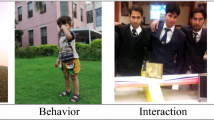Abstract
In this paper is presented a novel approach for human activity recognition (HAR) through complex data provided from wearable sensors. This approach considers the development of a more realistic system which takes into account the diversity of the population. It aims to define a general HAR model for any type of individuals. To achieve this much-needed processing capacity, this novel approach makes use of customizable, self-adaptive, self-development capacities of the so-called machine learning technique named evolving intelligent systems. An online pre-processing model to suit real-time capacities has been developed and is also explained in detail in this paper. Additionally, this paper provides valuable information on sensor analysis, online feature extraction, and evolving classifiers used for the attainment of this purpose.









Similar content being viewed by others
References
Andreu J, Dutta Baruah R, Angelov PP (2011) Real time recognition of human activities from wearable sensors by evolving classifiers. In: IEEE international conference in fuzzy systems (FUZZ), pp 2779–2785. doi:10.1109/FUZZY.2011.6007595
Angelov P, Buswell R (2001) Evolving rule-based models: a tool for intelligent adaptation. In: Proceedings of joint 9th IFSA world congress and 20th NAFIPS international conference, vol 1–5, pp 1062–1067. doi:10.1109/NAFIPS.2001.944752
Angelov PP, Zhou X (2008) Evolving fuzzy-rule-based classifiers from data streams. IEEE Trans Fuzzy Syst 16(6):1462–1475. doi:10.1109/Tfuzz.2008.925904
Angelov P, Zhou XW, Klawonn F (2007) Evolving fuzzy rule-based classifiers. In: IEEE symposium on computational intelligence in image and signal processing, pp 220–225. doi:10.1109/CIISP.2007.369172
Bao L, Intille SS (2004) Activity recognition from user-annotated acceleration data. Proc Pervasive Comput 3001:1–17. doi:10.1007/b96922
Chen W, Aghajan H, Kleihorst R (2008) Real-time human posture reconstruction in wireless smart camera networks. In: International conference on information processing in sensor network, pp 321–331. doi:10.1109/IPSN.2008.20
Dagher I (2010) Incremental PCA-LDA algorithm. In: International conference on computational intelligence for measurement systems and applications, pp 97–101. doi:10.1109/CIMSA.2010.5611752
Dutta-Baruah R, Angelov P, Andreu J (2011) Simpl_eClass: simplified potential-free evolving fuzzy rule-based classifiers. In: IEEE international conference on systems, man, and cybernetics (in press)
Lughofer E, Angelov P (2011) Handling drifts and shifts in on-line data streams with evolving fuzzy systems. Appl Soft Comput 11:2057–2068. doi:I10.1016/j.asoc.2010.07.003
Maurer U, Smailagic A, Siewiorek DP, Deisher M (2006) Activity recognition and monitoring using multiple sensors on different body positions. In: International workshop on wearable and implantable body sensor networks, pp 4–116. doi:10.1109/BSN.2006.6
Ravi N, Dandekar N, Mysore P, Littman ML (2005) Activity recognition from accelerometer data. In: Proceedings of the 17th conference on innovative applications of artificial intelligence, pp 1541–1546
Saponas S, Lester J, Froehlich J, Fogarty J, Landay J (2008) iLearn on the iPhone: real-time human activity classification on commodity mobile phones. Technical Report. University of Washington
Sun SPOT World (2011) Oracle Labs http://www.sunspotworld.com/. Accessed 20 July 2011
Tapia EM, Intille SS, Haskell W, Larson K, Wright J, King A, Friedman R (2007) Real-time recognition of physical activities and their intensities using wireless accelerometers and a heart rate monitor. In: 11th IEEE international symposium on wearable computers, pp 1–4. doi:10.1109/ISWC.2007.4373774
Trevisan J, Angelov PP, Carmichael PL, Scott AD, Martin FL (2010) A mathematical framework for spectroscopy data analysis to characterize chemical-induced alterations in the (SHE) assay (pH 6.7). Analyst 135:3266–3272. doi:10.1039/C0AN00586J
Wachenfeld S, Madeja M, Jiang XY (2010) Developing mobile multimedia applications on Symbian OS devices. In: Lecture notes in computer science, pp 238–263. doi:10.1007/978-3-642-12349-8_14
Author information
Authors and Affiliations
Corresponding author
Rights and permissions
About this article
Cite this article
Andreu, J., Angelov, P. An evolving machine learning method for human activity recognition systems. J Ambient Intell Human Comput 4, 195–206 (2013). https://doi.org/10.1007/s12652-011-0068-9
Received:
Accepted:
Published:
Issue Date:
DOI: https://doi.org/10.1007/s12652-011-0068-9




